When desktop 3D printing emerged a decade ago, the phrase “plug-and-play” was thrown around a lot to describe how user-friendly a given machine was. Nevertheless, none of the original desktop systems were ever truly plug-and-play. You had to tinker with them, level the print bed, and get the settings just right for every printed model and material. From then until now, there has been one company that has continuously improved its 3D printers to make them easy to use, affordable, and, above all, professional quality.
Spun out of the Massachusetts Institute for Technology, Formlabs immediately set itself apart from both the world of desktop printers and industrial equipment by offering the best of both worlds: an industrial quality machine that could fit on your desktop for a price of about $5,000. Since it blew away Kickstarter some ten years ago, the company has grown into one of the additive manufacturing sector’s few unicorns. Having never used a Formlabs 3D printer before, I always wondered if these machines lived up to the hype.
After unboxing and testing the latest iteration of the company’s flagship stereolithography (SLA) system for several weeks, that question was answered. The Form 3+ proved itself to be a repeatable, high-quality 3D printer suitable for a range of environments, from desktop prototyping to end-part manufacturing.
Setting up the Form 3+ 3D Printer
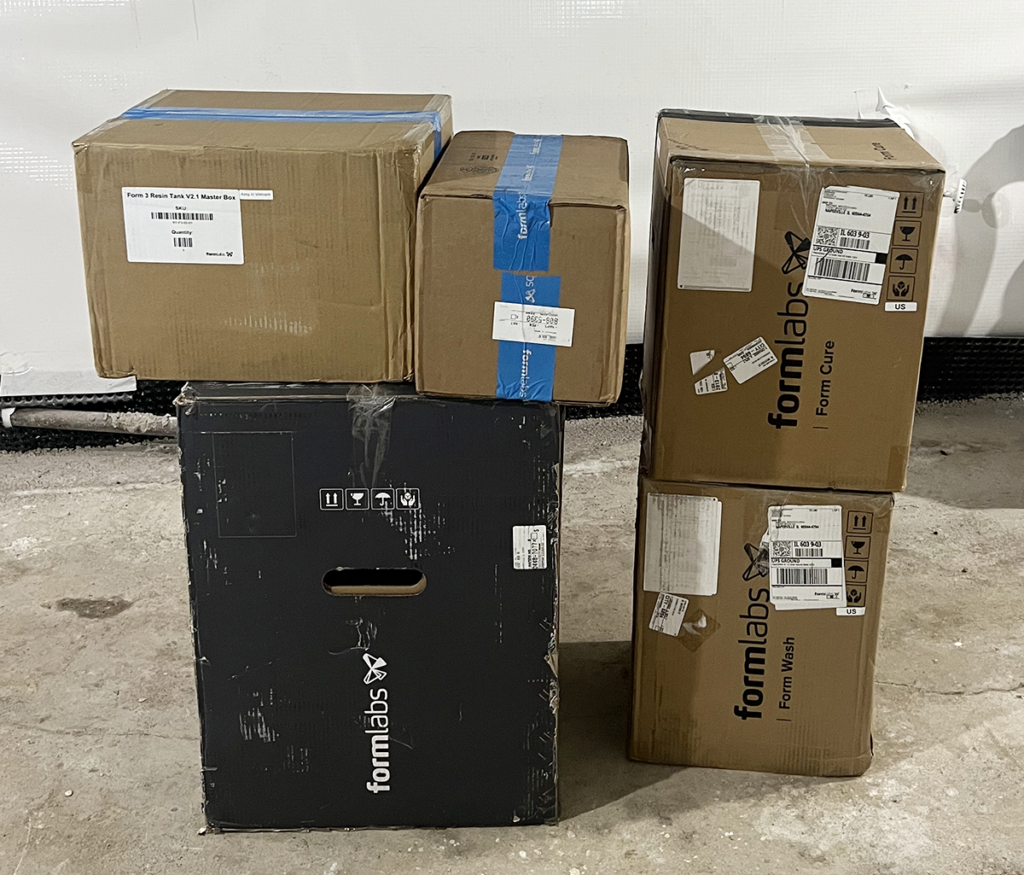 Boxes containing the Form 3+ 3D printer, Form Wash, Form Cure, and 3D printing resins and print trays.
Boxes containing the Form 3+ 3D printer, Form Wash, Form Cure, and 3D printing resins and print trays.To be honest, when a stack of boxes arrived on my doorstep, I was intimidated by the prospect of getting the Form 3+ up and running. Setting up a 3D printer is typically a laborious process, even when it boasts a full-color touchscreen with step-by-step instructions. In this case, however, there was virtually no set up. After removing it from the box and plugging it in, the Form 3+ was ready to go—literally plug and play.
Formlabs sent auxiliary equipment, as well: the Form Wash and Form Cure units. Because SLA works with photosensitive resin, it’s necessary to both rinse printed parts and then expose them to ultraviolet (UV) light so that they can achieve a fully hardened state. For a hobbyist, these machines aren’t completely necessary, in that it’s possible to simply wash objects in isopropyl alcohol (IPA) and then leave them out in the sun for a day. However, that’s obviously not the ideal workflow, nor is it sufficient for a professional environment.
Just like the printer itself, the Wash and Cure just needed to be plugged in and they were ready to go.
3D Printing on the Form 3+
Using the Form 3+, as well as the Preform software for prepping prints, is completely painless. Formlabs has dedicated significant time and energy to giving its technology the best user interface possible. Upon loading a 3D model to Preform, the software automatically determines its printability and, if it finds features that may not print properly, offers to correct them. It then highlights areas where support structures will be necessary to achieve a successful print and offers to create them automatically.
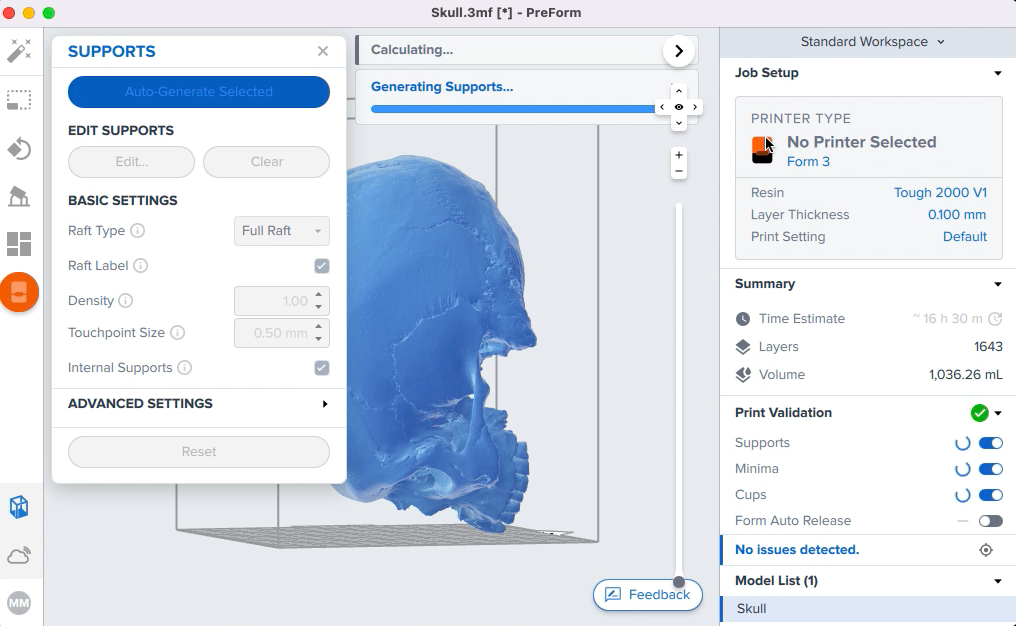 Formlabs’ Preform 3D printing prep software is easy to use, but offers additional complexity for advanced users.
Formlabs’ Preform 3D printing prep software is easy to use, but offers additional complexity for advanced users.Due to the limits of my own CAD and engineering skills, I let Preform make most of the decisions for me. However, the software is sufficiently sophisticated for advanced users that don’t want all of the print parameters chosen for them. Everything is designed for large production environments, as well, so features like Fleet Control via the cloud were also available, as was the ability to have the printer automatically eject a part for post-processing. Given that I was only reviewing the one printing unit, I did not test out these features.
Photopolymers are typically messy and toxic, but Formlabs has contained these volatile materials in simple cartridges that can be inserted into the printer without the user coming into contact with the resins themselves. The Form 3+ automatically registers the material that has been loaded into it so that it can adjust its settings accordingly.
Once the material and model are ready to go, the Form 3+ kicks off the print, allowing the user to monitor remotely via a status bar in the cloud or directly on the printer itself. Unlike cheaper, more common filament melting machines, this SLA system never startled me with an incomplete print. No piles of plastic spaghetti. Every day when I would check on a job, I’d find a part that was perfectly made.
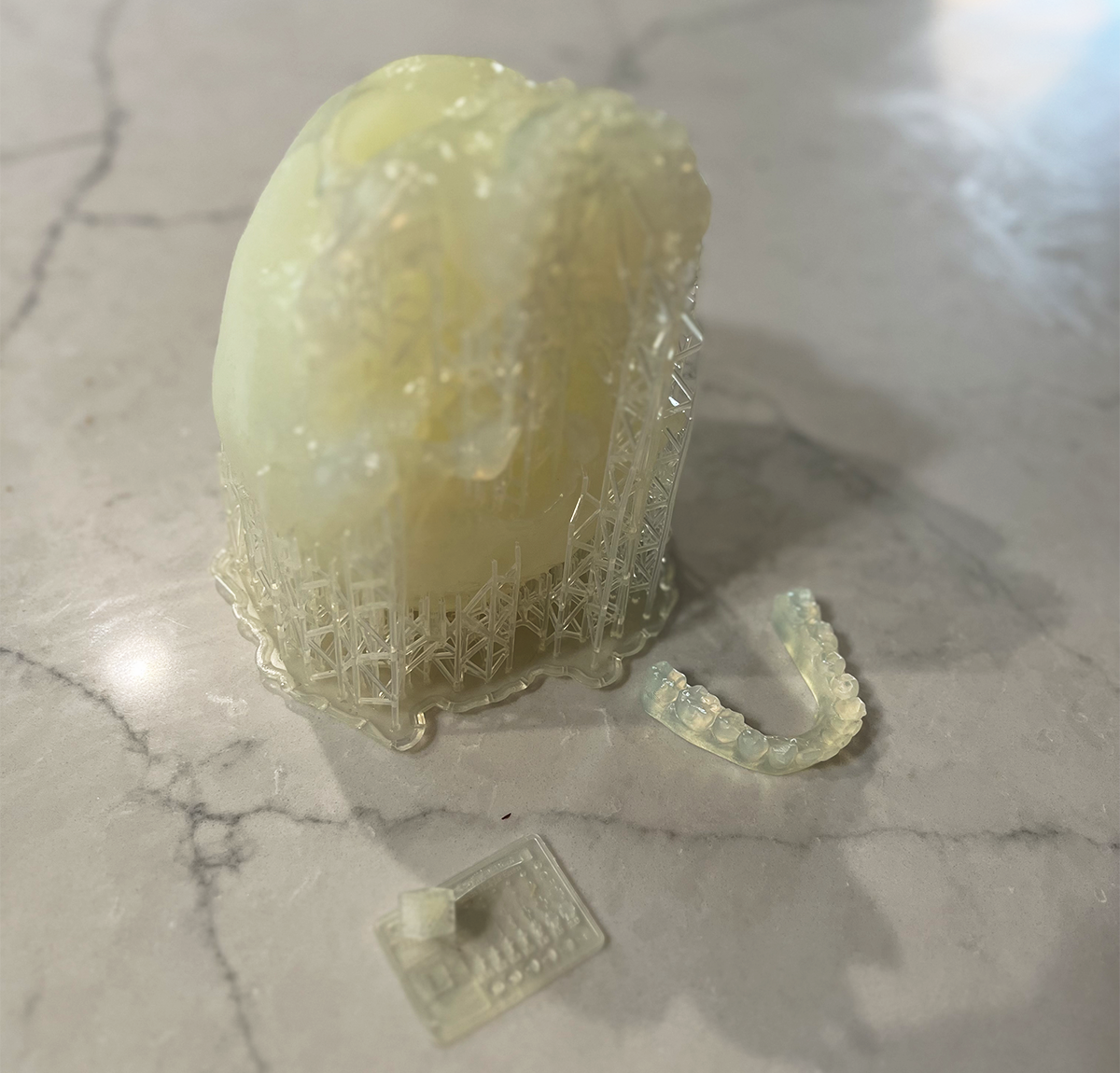 Formlabs’ Durable resin is designed for more basic printing operations, such as prototyping. The numerous support structures on the skull were removed in almost no time with very little effort.
Formlabs’ Durable resin is designed for more basic printing operations, such as prototyping. The numerous support structures on the skull were removed in almost no time with very little effort.Completed objects are removed from the Form 3+. Either the individual items or the entire print bed can be placed into the Form Wash system, which is agitates the parts in a tub full of rubbing alcohol for about 10 minutes before they are moved into the Form Cure. There, they are exposed to UV light for roughly an hour.
The Form Wash comes with a slew of accessories for processing the prints, including a metal spatula for removing printed parts from the build bed and scissors for removing supports. Formlabs recently introduced a specialty build bed that renders the spatula almost unnecessary. By squeezing the handles on the device, the metal bed bends and the part pops off. The scissors are still needed, but the support structures are optimized in Preform so that they require minimal effort to remove. I was blown away when taking these elements off of a skull—which occupied nearly the entire build volume of the printer—took less than a minute.
Applications for the Form 3+ 3D Printer
SLA is typically used for the very high resolution capable with the technology, which was fully evident in the parts I made with the review unit. Formlabs’ SLA machines have become mainstays of the dental, medical, and jewelry industries, where the detail and precision of the printers are key for printing items that will be cast in metal or serve as clear surgical guides.
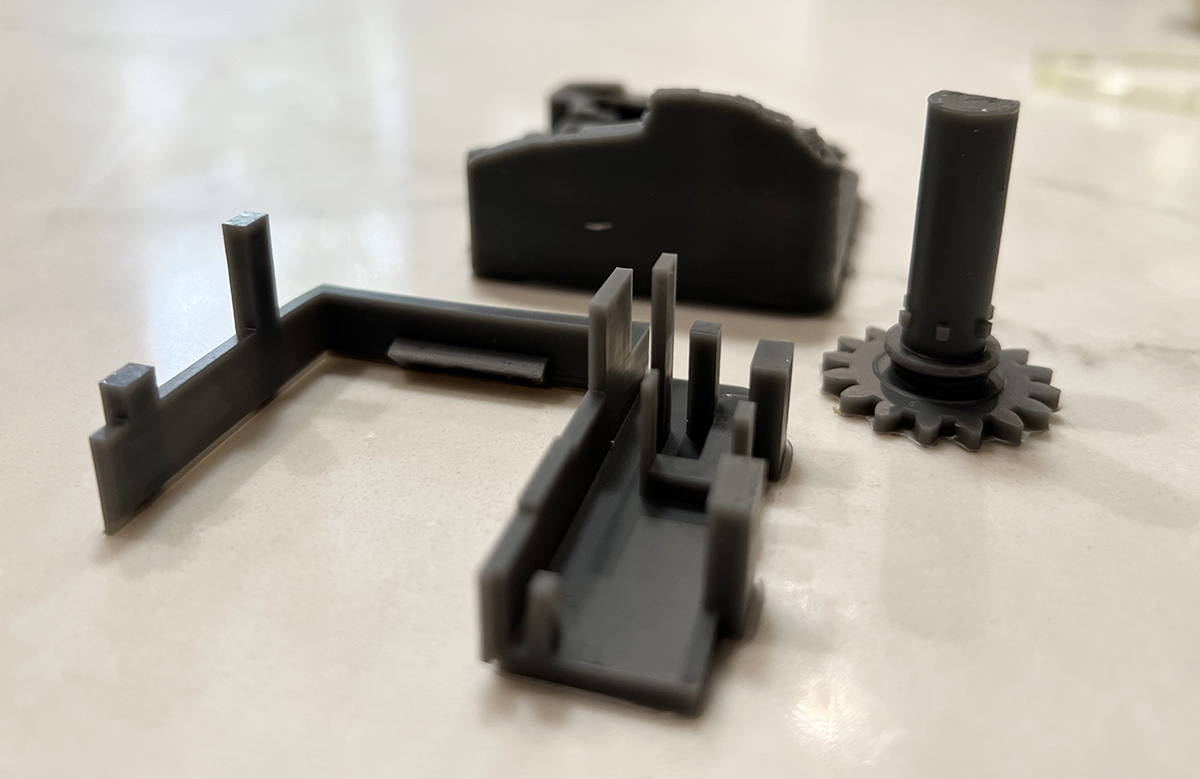 These parts made with Tough 2000 resin are meant for a 3D printed camera.
These parts made with Tough 2000 resin are meant for a 3D printed camera.Using the Durable, Clear, and Tough 2000 resins provided to me, I made a variety of objects that might take advantage of this high resolution in the real world. This included a dental model, which could be used to create an invisible aligner, as well as pieces of jewelry, and an archeological artifact.
Because Halloween was around the corner, I opted for a skull that would serve the dual purpose of demonstrating how this printer might be used for educational and archeological applications and creating decorations. The model I printed happened to be made from a 3D scan of skull found on the Battle of Visby, where, on July 27, 1361, the Danes fought Gutnic Peasants.
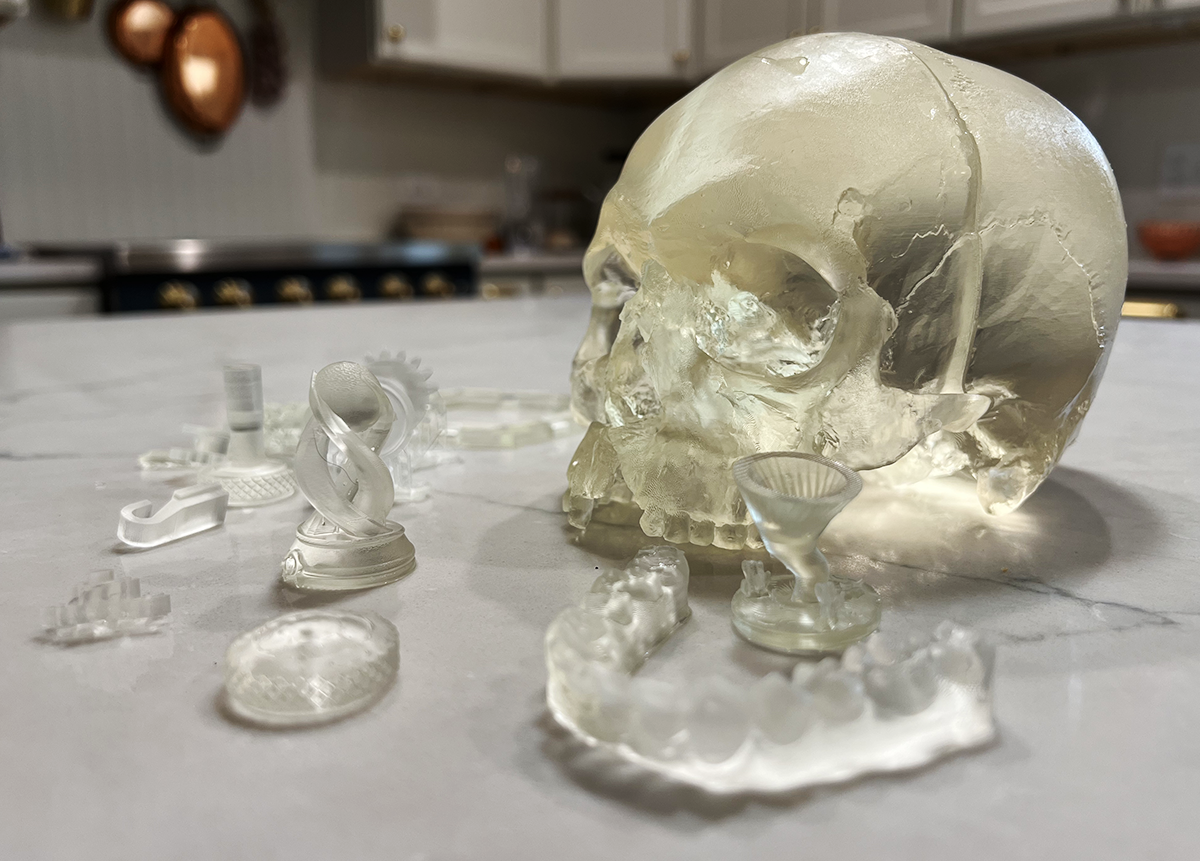 The Clear resin was stunningly clear. The yellowish tint on the skull is likely from the sheer density of the part.
The Clear resin was stunningly clear. The yellowish tint on the skull is likely from the sheer density of the part.All parts came out phenomenally and I experienced no hiccups during the entire review process. This along with the low cost makes it no surprise that companies as large as Hasbro HAS have used the Form 3 for end part production, which is further streamlined with Formlabs’ more recent automation efforts.
The Form Auto streamlines 3D printing with the Form 3+ by autonomously detaching completed components from the build platform and initiating subsequent prints, eliminating the necessity for manual intervention. Just recently, similar automation was introduced for the company’s powder bed 3D printing technology that allows for depowdering, cleaning, and polishing of thermoplastic parts automatically.
 A variety of parts made on the Form 3+ using three types of resins.
A variety of parts made on the Form 3+ using three types of resins.While it was a shame to have to send the Form 3+ back to its makers once my review was complete, it was helpful to know that there were plenty of other units out in the world aiding in the world of manufacturing at large.
Subscribe to Our Email Newsletter
Stay up-to-date on all the latest news from the 3D printing industry and receive information and offers from third party vendors.
You May Also Like
Further Understanding of 3D Printing Design at ADDITIV Design World
ADDITIV is back once again! This time, the virtual platform for additive manufacturing will be holding the first-ever edition of ADDITIV Design World on May 23rd from 9:00 AM –...
3D Printer Maker EVO-tech Reborn as NEVO3D — Once More With Feeling
EVO-tech was a 3D printing service and original equipment manufacturer established in 2013 and based in Schörfling am Attersee, Austria. The company produced high-quality material extrusion systems featuring linear bearings,...
3D Systems Brings 3D Printed PEEK Cranial Implant to the U.S. with FDA Clearance
For more than 10 years, 3D Systems (NYSE:DDD) has worked hand-in-hand with surgeons to plan over 150,000 patient-specific cases, and develop more than two million instruments and implants from its...
CDFAM Returns to Berlin for Second Annual Symposium
The second CDFAM Computational Design Symposium is scheduled for May 7-8, 2024, in Berlin, and will convene leading experts in computational design across all scales. Building upon the first event...































